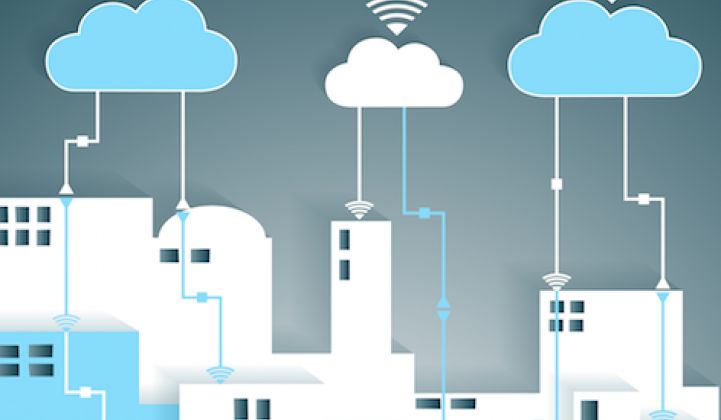A few years ago, our team defined the concept Enterprise Smart Grid (ESG) as a way to describe the systems and businesses providing visibility and control for buildings that interact dynamically with the grid. We portrayed an overwhelming number of ESG vendors in our market landscape picture.
Now, a few years later, there’s a quiet follow-on trend being considered by commercial and industrial companies: outsourcing energy management.
For most C&I customers, energy costs still remain non-strategic, with only a few mid-level managers focused on the line item. But recently it’s gotten even harder for this group to tactically forecast and manage down costs.
And the number of vendors offering solutions is still overwhelming. In some cases, outsourcing could be a competitive advantage; in some cases, a response to a competitive threat. Either way, many are considering it.
The days of locking in indexed commodity contracts with lower annual rates thanks to collapsing natural-gas prices are gone. Many utilities, struggling with ISO/RTO capacity constraints, are signaling demand-charge inflation and time-of-use (TOU) pricing. This means managers have extra homework, as they now need to know where and when consumption is occurring in order to forecast and control it.
Utility incentives with performance requirements and load response programs look like free money, but require a deep understanding in how it could impact a company’s operation. Efficiency enthusiasts push customers to consider upgrading their facilities. Solar companies tell them to consider distributed generation. And how would they implement a microgrid if they wanted to derisk the whole thing? Meanwhile, many are still burdened with annual climate reporting filings detailing how much more environmentally efficient they’ve become.
Not surprisingly, companies are asking who can manage this process for them. This is where Energy Managed Services come in.
In simple terms, let’s define it.
[en-er-jee man-ij-duh sur-vis-ez]
noun, plural
- Proactive remote control of energy consuming systems, optimizing for efficiency, under a subscription model and without negative impact to building occupants or operations.
- The Nest thermostat provided energy managed services for the homeowner’s HVAC system.
Fifteen years ago, corporate IT fell in love with the managed service concept. Coming off SAP and Oracle implementation heartburn, companies were principally focused on internet network security, unable to respond to a wave of new internal internet functionality requests. The stage was set for IT managed services to fill the gap.
New managed service providers (MSPs) signed them to long-term service contracts, outsourcing everything from call centers to firewall management. The MSPs leveraged high-speed internet connections and brought easy-to-use SaaS interfaces. At 2 a.m., while corporate IT was still putting out fires, MSPs added staff in other times zones and could scale up to meet problems quickly.
In 2016, a similar phenomenon could be playing out with energy management software.
Companies have seen a wave of magical energy-centric software, all claiming it can fix their energy pain. They’re being pitched by large and startup vendors, their utilities, their commodity providers and their own people. The solutions can be interesting and compelling -- but remain complex and with uncertain financial returns. A number of startups with big promises have already disappeared.
The corporate stage is set for someone to manage the whole energy thing (or at least a big chunk of it) from afar.
Enter the Energy Managed Service Provider (yup, another acronym -- EMSP). A few EMSPs have been already been operating for years, albeit in narrow application areas.
Summit Energy (acquired by Schneider Electric in 2011) built a business managing outsourced utility bill management, coupling this service to commodity purchasing. EnerNOC has been providing it for the load response markets. Multi-year, utility-scale corporate PPAs like First Solar’s with Apple, have given large corporates green kilowatt-hours, while letting the PPA owners worry about installing and managing the array and monetizing the federal ITC.
Newer companies like BuildingIQ and Phoenix Energy Technologies (recently acquired by Duke Energy) have gained momentum using their managed service to control corporate HVAC costs, the C&I equivalent to Nest managing your home’s system. They monitor 24x7x365, control directly or through off-line communication and have a clear energy savings value proposition.
Stem and Tesla are doing it with batteries, enabling storage managed resources for utilities like SoCal Edison. Beyond these, we’re seeing increasing experimentation in every category of energy management systems, from LED lighting to compressed air to cogeneration. Vendors are leveraging cloud software and internet-of-things technology control to deliver the managed services.
The next phase of EMSP adoption will likely be catalyzed by real or perceived energy cost escalation to commodity base rates, demand charges or TOU pricing. It will hit the largest energy consumers first.
The most strategic EMSPs will need to address more than one area of energy management, similar to how battery backup and solar can be technically and economically linked. They’ll need a software-based technical edge that’s hard for customers to do themselves -- that is, present real value as a software-service. And long-term contracts will need to pencil out with hard-dollars savings that don’t require customers to change the way they run their business operation.
And in contract negotiation, they’ll need to remember outsourcing psychology: if it goes too well, customers can take energy management back in-house at some point in the future.
***
Jon Guerster is the CEO of Groom Energy Solutions.
Are you an energy manager? The Grid Edge Customer Network is an exclusive group of end-use customers who are charged with making enterprise-wide energy management decisions. Learn about membership here.



